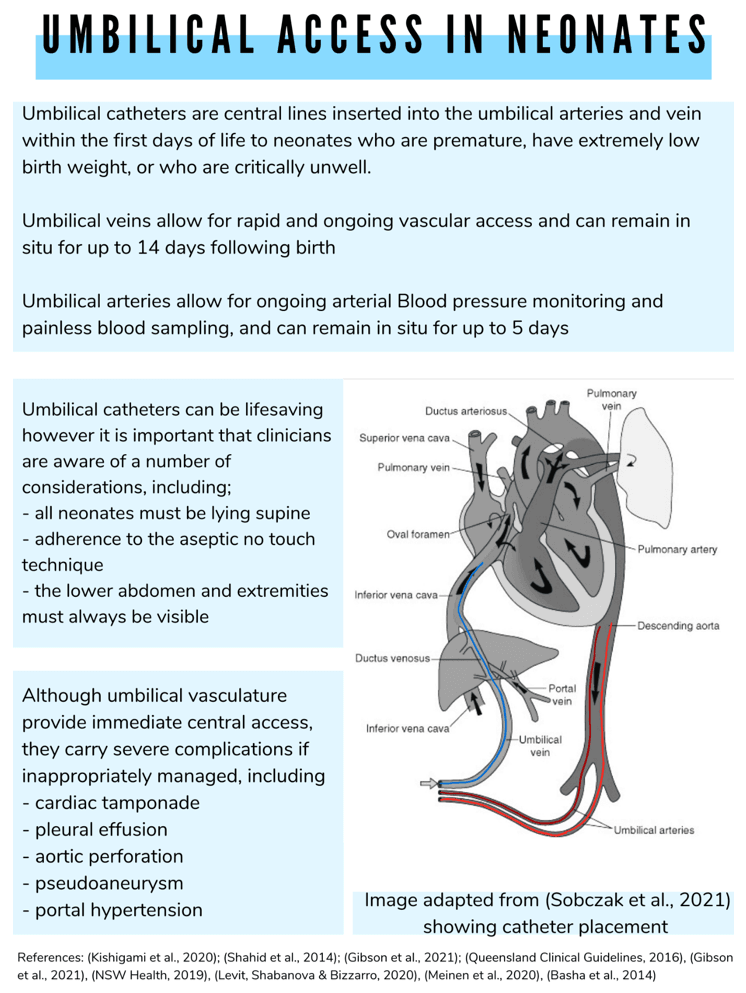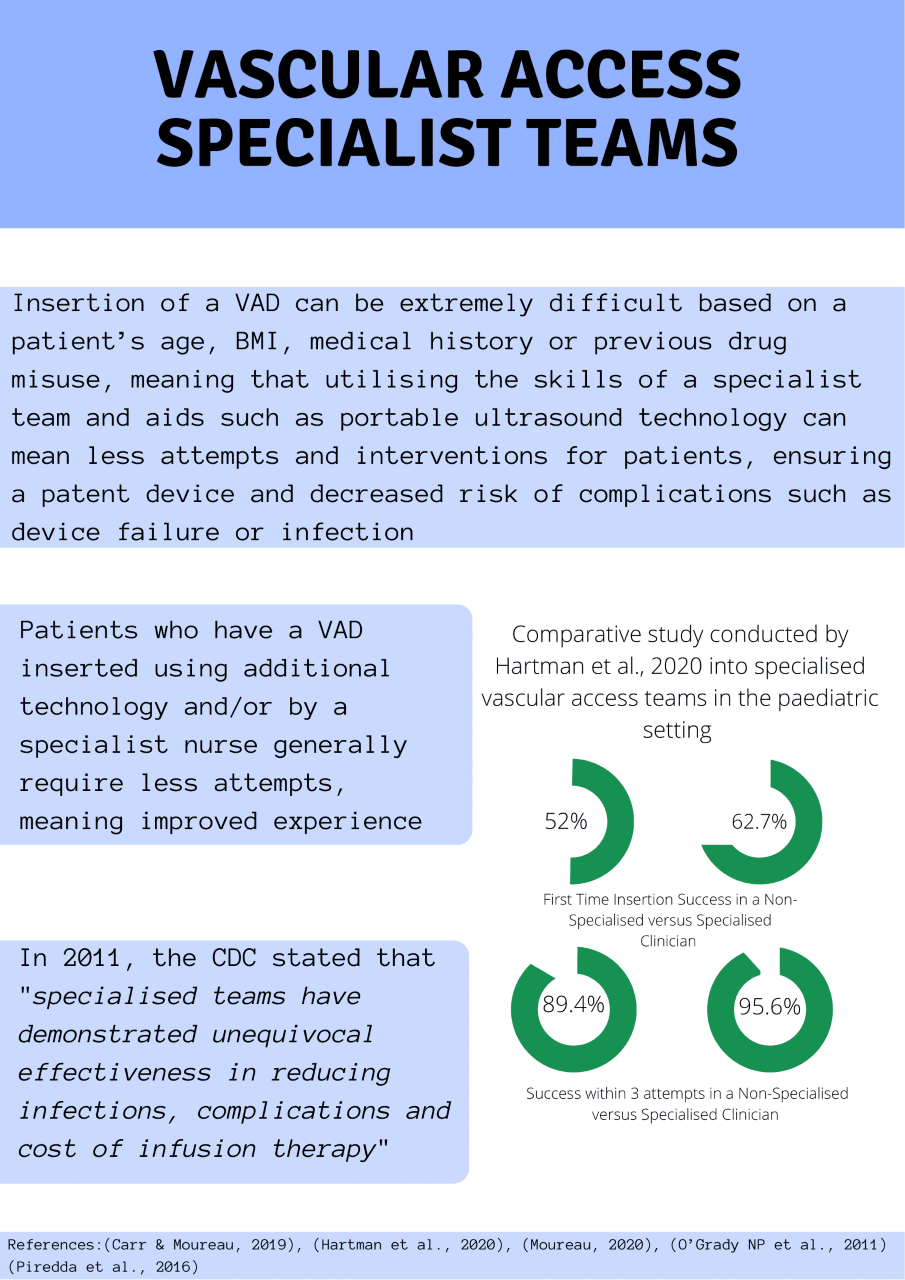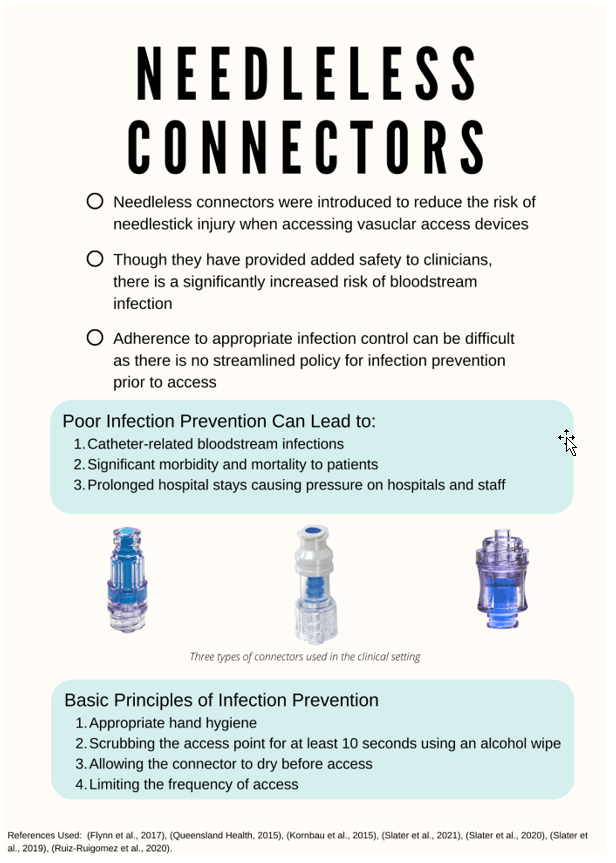Umbilical Catheters
Posted by Lizzy Ostwald
on 7 October 2021
)
What is an umbilical catheter?
Umbilical catheterisation is a procedure performed by highly skilled neonatal clinicians shorty after birth in premature or critically unwell neonates1. The procedure allows for central venous and arterial access, enabling administration of medications and fluids, painless blood drawing, and continuous blood pressure monitoring2,3.
Umbilical venous catheters are inserted through the umbilical vein and travel through the ductus venosus, through to the inferior ...
| Posted in:central vascular access devicesumbilical catheters |
3M Health Care Academy - The 2021 INS Infusion Therapy Standards of Practice: Focusing on Catheter Securement: Science and best practices
Posted
on 29 September 2021
| Posted in:dressingsIV managementsecurementvascular access devicesguidelines |
Vascular Access Specialist Teams
Posted by Lizzy Ostwald
on 24 September 2021
)
The insertion of a vascular access device (VAD) is one of the most common invasive procedures performed in the hospital setting, however a number of factors across adult and paediatric populations including age, weight extremes, comorbidities, previous difficult intravenous access, and site selection for current VAD can significantly impact overall insertion success and maintenance of a device.1,2
Dedicated vascular access teams are made up of competent clinicians trained to maxi...
| Posted in:insertionvascular access devicesspecialist teams |
Essentials of Needleless Connector Care
Posted by Lizzy Ostwald and Gillian Ray-Barruel
on 23 September 2021
)
Introduced in the 1990s, needleless connectors have become an essential component of 21st century medical care, as they have removed the inherent needle stick injury risk associated with older needle-based connectors.1 Used on both central and peripheral vascular access devices, they allow for the safer administration of medication, fluid and blood.2
However, needleless connectors carry a significantly increased risk of bloodstream infection. If the injection site has not been properly ...
| Posted in:infection preventionneedleless connectorcatheter-associated bloodstream infection |
Central line bloodstream infections: CLABSI or CRBSI?
Posted by Lizzy Ostwald
on 21 September 2021
)
Central venous access devices (CVADs) are an essential component of contemporary medical care, allowing for incompatible medications to be administered simultaneously and reduce the need for peripheral vascular access, particularly for critically ill or oncology patients.1
However, CVADs can entail significant risk. Bloodstream infection is the most detrimental consequence of inadequate CVAD management, presenting a significant burden to the patient, staff and economy of a hospital, especial...
| Posted in:central vascular access devicescatheter-associated bloodstream infection |
PIVCs in Neonates: Caution advised!
Posted by Lizzy Ostwald
on 20 September 2021
)
Peripheral intravenous cannulation (PIVC) is commonplace in the neonatal setting, particularly in premature and critically unwell neonates who are unable to regulate homeostatic balance.1
Cannulation of a neonate can be difficult, given the significantly smaller venous anatomy and compromised skin integrity which can lead to localised toxicity and inflammation.2 Failure rates can be high, with 95% of PIVCs being removed due to complications including occlusion, leaking and extravasation inju...
| Posted in:peripheral intravenous catheterassessmentneonate |
Tips for PIVC Location and Size
Posted by Lizzy Ostwald
on 19 August 2021
Of the 11 million Australians accessing care in a hospital each year, an estimated 7.7 million will receive a peripheral intravenous catheter (PIVC), also called a cannula, meaning this procedure is commonplace, particularly in the emergency department.(1) Although this is such a common procedure, first-attempt failure rates are high, with an estimated 40% failure rate in adults and 65% in the paediatric population.(1)
All clinicians who are cannulation competent must be abl...
| Posted in:peripheral intravenous cathetercannulapatient experienceIV insertionvessel health |
Why catheter-to-vein ratio matters!
Posted by Gillian Ray-Barruel
on 19 August 2021
Did you know that certain catheter-to-vein (CVR) ratios can have twice the risk of thrombosis in patients with cancer?
Dr Rebecca Sharp from the University of South Australia (UniSA) and Australian Vascular Access Society has published a study in BMJ Open that analysed the outcomes of more than 2400 patients from 4 hospitals in Australia and New Zealand who received a peripherally inserted central catheter (PICC). The study found that up to 6% of patients with cancer who had received chemo...
| Posted in:catheter failurecentral vascular access devicesPICCultrasoundevidence-based practice |
Making it stick! A recap of VAD securement
Posted by Lizzy Ostwald
on 26 July 2021
Being aware of appropriate securement techniques is essential when caring for a vascular access device (VAD). Whether arterial or venous, when a VAD dislodges, it becomes useless, which can lead to delayed treatment and prolonged hospital admission.1 As such, clinicians need to understand the importance of securement techniques that can prevent dislodgement and the subsequent possible complications.2
Suture-less securement devices are commonplace in hospital settings, seen most commonly i...
| Posted in:dressingsIV managementsecurementvascular access devices |










